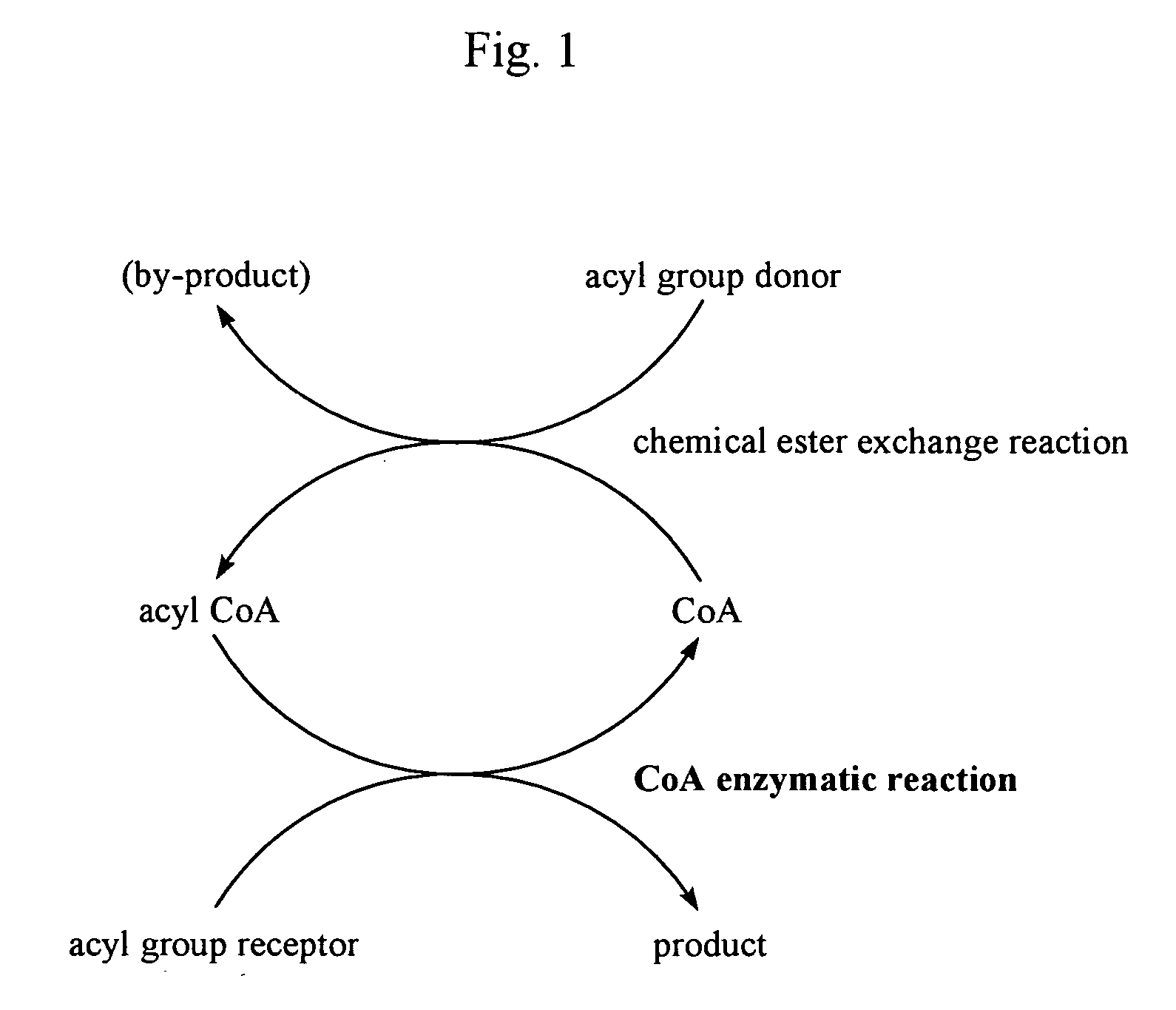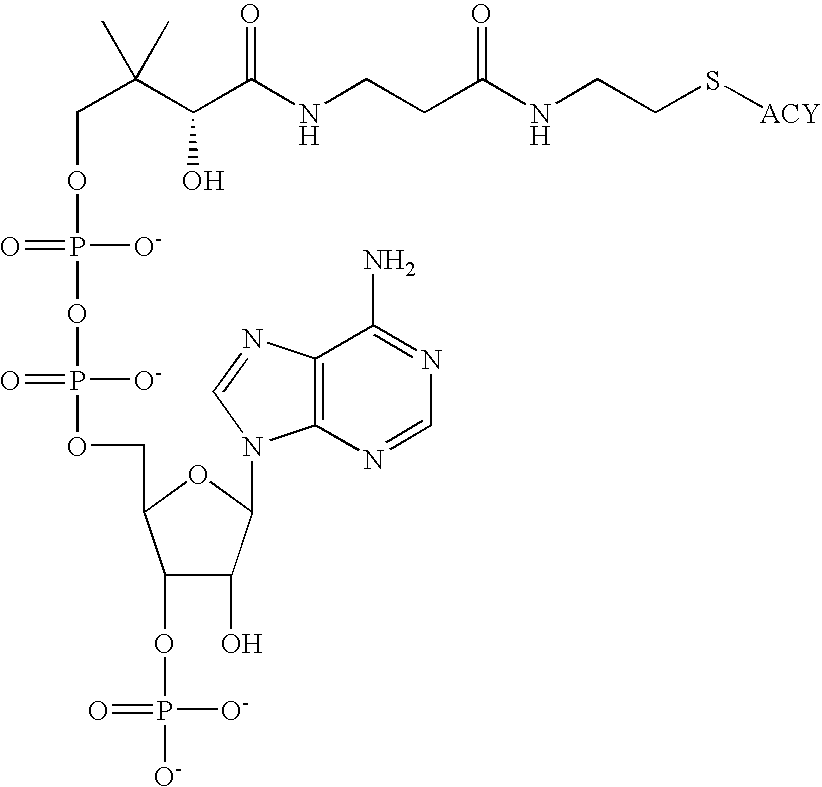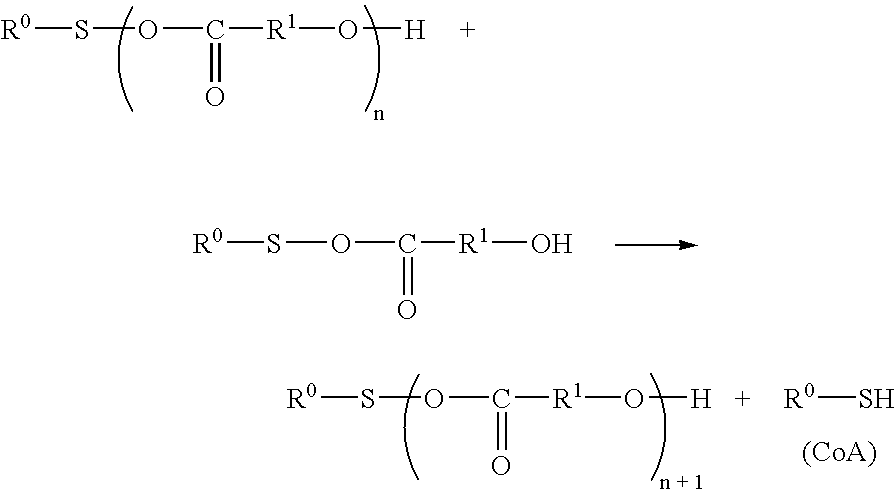Process for acyl-transfer enzyme reactions with acyl-coenzyme a
a technology of acylcoenzyme and acyltransferase, which is applied in the field of acyltransferase reaction, can solve the problems of difficult to obtain the enzyme which serves as a catalyst in a necessary amount, high cost of acyl coa production as such, and achieve the effect of dramatically reducing the consumed amount of acyl coa
- Summary
- Abstract
- Description
- Claims
- Application Information
AI Technical Summary
Benefits of technology
Problems solved by technology
Method used
Image
Examples
example 1
Synthesis of acyl thiophenol (thiophenyl palmitate)
[0103] Anhydrous dichloromethane (6 mL) was added to a well-dried and nitrogen-substituted flask and well stirred with cooling on ice. A 2M trimethyl aluminum (2 mL) was slowly added thereto. Further, thiophenol was slowly added thereto. After the mixture was stirred at room temperature for 1 hour and 30 minutes, ethyl palmitate dissolved in 6 mL of anhydrous dichloromethane was slowly added thereto to conduct a reaction. The reaction was monitored by TLC. After completion of the reaction, 20 mL of dichloromethane was added to the reaction solution and then a 3% aqueous solution of hydrochloric acid was added until no more generation of bubbles was observed. The solution was transferred to a separating funnel, washed with a 3% aqueous solution of hydrochloric acid for three times and with saturated saline for two times, dried over magnesium sulfate, filtered to remove magnesium sulfate and the filtrate was concentrated using an eva...
example 2
Preparation of serine C-palmitoyl transferase (SPT)
[0104] A crude SPT enzyme extract was prepared from a transformant where the above-mentioned enzyme derived from genus Sphingomonas was cloned to Escherichia coli. Preparation of the present transformant and method for purification of SPT were in accordance with the descriptions in The Journal of Biological Chemistry, 276, 18249-18256 (2001) by H. Ikushiro, et al.
[0105] Firstly, primers (SEQ ID NO: 1 and SEQ ID NO: 2) coding N-terminal sequence and C-terminal sequence were prepared from total base sequence of the above SPT and a DNA fragment corresponding to the SPT coding region was made by a PCR under the following condition using a chromosome DNA of Sphingomonas paucimobilis as a template. At that time, NcoI site for connecting to a vector and Hind III site were formed for the primer for N-terminal and for the primer for C-terminal, respectively.
[Primers]Primer for N-terminal:(SEQ ID NO: 1)5′-accatgaccgaagccgccgctca-3′Primer ...
example 3
Coupling of Ester Exchange Reaction with CoA Enzymatic Reaction (Uniform Aqueous System)
[0117] CoA sodium salt (2 mg) and 1 mg of L-serine were dissolved in 5 mL of 100 mM HEPES-NaOH buffer (containing 10 μM PLP, pH 8.0) and well stirred using a magnetic stirrer. That was mixed with a solution of 3.5 mg of thiophenyl palmitate in 0.1 mL of acetonitrile. While the stirring speed was made reduced to such an extent that a gentle mixing was resulted, 0.5 mL of crude SPT enzyme solution was added and the mixture was made to react at 37° C. for 24 hours. The solution was made alkaline with 1 mL of 2N ammonia solution and the product in the solution was extracted and recovered with 5 mL of chloroform / methanol (2:1 (v / v)). The extract liquid was filtered, appropriately concentrated and subjected to a quantitative determination for 3-ketodihydrosphingosine according to the following analytic method whereupon the produced amount was about 1.0 mg.
[Analysis of sphingosines]
[0118] Quantitativ...
PUM
| Property | Measurement | Unit |
|---|---|---|
| temperature | aaaaa | aaaaa |
| temperature | aaaaa | aaaaa |
| temperature | aaaaa | aaaaa |
Abstract
Description
Claims
Application Information
 Login to View More
Login to View More - R&D
- Intellectual Property
- Life Sciences
- Materials
- Tech Scout
- Unparalleled Data Quality
- Higher Quality Content
- 60% Fewer Hallucinations
Browse by: Latest US Patents, China's latest patents, Technical Efficacy Thesaurus, Application Domain, Technology Topic, Popular Technical Reports.
© 2025 PatSnap. All rights reserved.Legal|Privacy policy|Modern Slavery Act Transparency Statement|Sitemap|About US| Contact US: help@patsnap.com



